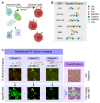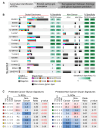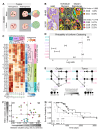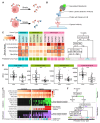This is a preprint.
Multiplexed Glycan Immunofluorescence Identification of Pancreatic Cancer Cell Subpopulations in Both Tumor and Blood Samples
- PMID: 39229066
- PMCID: PMC11370594
- DOI: 10.1101/2024.08.22.609143
Multiplexed Glycan Immunofluorescence Identification of Pancreatic Cancer Cell Subpopulations in Both Tumor and Blood Samples
Update in
-
Multiplexed glycan immunofluorescence identification of pancreatic cancer cell subpopulations in both tumor and blood samples.Sci Adv. 2025 Mar 7;11(10):eadt0029. doi: 10.1126/sciadv.adt0029. Epub 2025 Mar 7. Sci Adv. 2025. PMID: 40053601 Free PMC article.
Abstract
Pancreatic ductal adenocarcinoma (PDAC) tumor heterogeneity impedes the development of biomarker assays suitable for early disease detection that would improve patient outcomes. The CA19-9 glycan is currently used as a standalone biomarker for PDAC. Furthermore, previous studies have shown that cancer cells may display aberrant membrane-associated glycans. We therefore hypothesized that PDAC cancer cell subpopulations could be distinguished by aberrant glycan signatures. We used multiplexed glycan immunofluorescence combined with pathologist annotation and automated image processing to distinguish between PDAC cancer cell subpopulations within tumor tissue. Using a training-set/test-set approach, we found that PDAC cancer cells may be identified by signatures comprising 4 aberrant glycans (VVL, CA19-9, sTRA, and GM2) and that there are three glycan-defined PDAC tumor types: sTRA type, CA19-9 type, and intermixed. To determine whether the aberrant glycan signatures could be detected in blood samples, we developed hybrid glycan sandwich assays for membrane-associated glycans. In both patient-matched tumor and blood samples, the proportion of aberrant glycans detected was consistent. Furthermore, our multiplexed glycan immunofluorescent approach proved to be more sensitive and more specific than CA19-9 alone. Our results provide proof of concept for a novel methodology to improve early PDAC detection and patient outcomes.
Conflict of interest statement
Conflict-of-interest statement: The authors have declared that no conflict of interest exists.
Figures





References
-
- Siegel RL, et al. Cancer statistics, 2023. CA: A Cancer J Clin. 2023;73(1):17–48. - PubMed
-
- Bailey P, et al. Genomic analyses identify molecular subtypes of pancreatic cancer. Nature. 2016;531(7592):47–52. - PubMed
-
- Chan-Seng-Yue M, et al. Transcription phenotypes of pancreatic cancer are driven by genomic events during tumor evolution. Nat Genet. 2020;52(2):231–240. - PubMed
Publication types
Grants and funding
LinkOut - more resources
Full Text Sources
